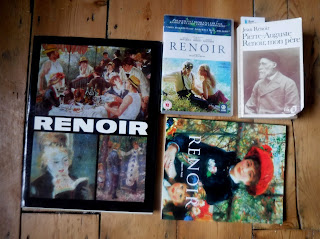some thoughts on
Pierre-Auguste Renoir, mon père
by Jean Renoir
Hachette 1962 / Gallimard 1981
an English translation from 2001 is also available
Back in 2013, the film Renoir was one of the few French movies that still made it to our local independent cinema, and I was lucky to catch it there, and then watched it again when it came out on DVD. It is about the last years in the life of the painter, after the death of his wife, Aline Charigot, in 1915. Auguste Renoir (1841-1919) is stuck in a wheelchair and barely able to move his hands, two of his sons get injured in the war, but he creates some of his most vibrant and life-affirming art.
By the time I started looking at paintings, the impressionists had become mainstream to the point of commercial overload, so I’ve never been a huge fan these works although I don’t mind seeing them every once in a while. The film, however, made me appreciate Renoir a bit more and as a result I picked up a few books about him at various charity shops and antiques fairs, including the memoir by his middle son, the film director Jean Renoir (1894-1979). The idea of the changing of the guard in visual arts, one of the first great film makers writing about one of the last impressionists to remain active in the 20th century, intrigued me so I actually read the book, assisted by the other volumes to look up paintings mentioned and consult timelines.

The biography is based on conversations Jean Renoir had with his father in the last year of his life, as well as with his long-serving model Gabrielle Renard (1878-1959) and other surviving witnesses. As the age gap between father and son is more than half a century, his own recollections only become useful towards the end of the story.
It is organised broadly chronologically, although the author tends to digress on thematic excursions, and covers a staggering range of historical change. From his childhood in the 1840s, Renoir remembered an old man who visited his parents regularly and happily shared memories of how he helped operating the guillotines in the French Revolution. Renoir’s family moved to Paris before it was completely reshaped by Haussmann in the 1850s, he experienced the restored monarchy and as he lived in the Tuileries, he played under the windows of the actual queen. Like some of the other impressionists, he lived and worked in Montmartre when it was still a village with wooden shacks, long before Sacré Coeur was built.
The complete rejection of the impressionists by critics, public and art officialdom in the 1870s is a well-trodden story but always fun to read. Apart from having fun with quoting from the hilarious reviews of the first exhibitions (one of which gave us the word “impressionists” for the artists who had called themselves “les intransigeants” initially), he highlights the occasions when French institutions like the Louvre wouldn’t even take the paintings for free, resulting in many of them winding up in North America. For instance, the painter and collector Gustave Caillebotte died in 1894 leaving his vast collection to the state and installing Renoir to execute his will. Initially the Louvre (as the official repository of the state’s art collection) didn’t want to be bothered with any of it. Three years later, they saw sense and accepted a part of the collection. Not sure if anybody has calculated what the Caillebotte collection would be worth today – I suspect you’d have to be very good in calculating with trillions and such like.
Renoir, who famously identified as a craftsman rather than an artist and considered the word intellectual an insult, comes across as an interestingly complex mixture of old-fashioned and revolutionary, which is part of the force field that keeps this book interesting, even though it isn’t the most organised biography ever written. That and the chance to meet the people you already know from those famous paintings. In another very famous French movie, Amélie, there’s the painter who copies Renoir’s Déjeuner des canotiers (1881) over and over again. Jean Renoir describes the setting and can identify most of the participants, mostly faithful friends of the painter. The woman at the front left, playing with a little dog, is Aline, the author’s mother. When we see these pictures in museums or on countless wall calendars, they are just paintings – but for Jean Renoir and the rest of the family they were life.
Oh, and I'll just have to watch the movie a third time, now I know the family so much better.



















